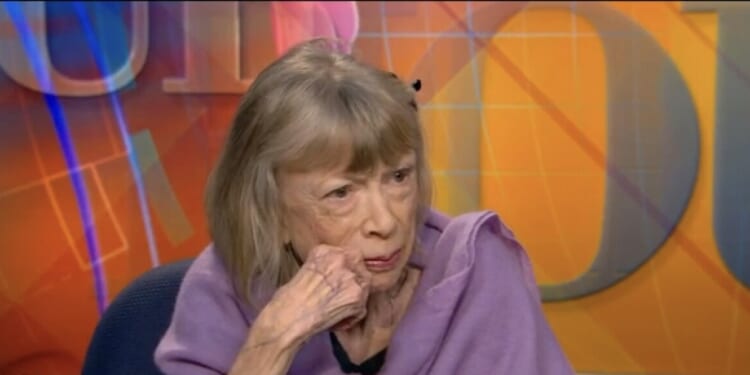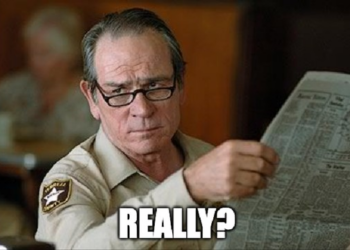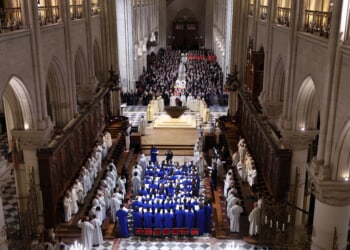Well, it looks as if it’s time once again for my more or less annual piece about Joan Didion.
I didn’t set out to make this a yearly tradition. Way back in 2007, I wrote what I thought was a pretty definitive essay for the Hudson Review about Didion’s career, noting, among much else, the way in which she managed to balance self-love with self-discipline, “chronic anxiety” with “stylized world-weariness,” relentless self-mythologizing with a calculated air of personal mystery. If, reporting on El Salvador or Miami or the lawless New York of the Dinkins era, she came off as being preoccupied with “social entropy, the center failing to hold,” I argued, it was not because she was concerned as an empathic human being with the question of how to set things aright, but because she fetishized disorder and sought to come off, for all her unashamedly advertised neuroticism and emotional fragility, as a fearless and profound observer of the anarchy that had been loosed upon the world.
Moral questions? She seems to have considered them beneath her. When the Iron Curtain fell, lesser scribes celebrated the liberation of millions from tyranny; but to Didion, such combinations of words — “the liberation of millions from tyranny” — were hopelessly vulgar, cliched, sentimental. So it was that only a month after that extraordinary event, you could find her sneering condescendingly, in the New York Review of Books, about the “Evil Empire” rhetoric by Reagan that had helped lead to the Soviet Union’s collapse. (So unreal — or unimportant — to her was the suffering of the people behind the Iron Curtain, by the way, that she even put the word “communism” into scare quotes.)
Even more reprehensible was her slim book Fixed Ideas (2003), in which she used 9/11 as an opportunity to set herself apart from everyone else who’d written about that atrocity, and thereby demonstrate what she apparently viewed as her singular integrity as a writer: deploring the sentimentality, patriotism, and hero-worship that she saw all around her, she reminded us, in that awful little volume, that, as I put it, her “interest in violence ha[d] absolutely no moral dimension”; for her, it seemed, it was almost as if the mangled remains of the Twin Towers were there for no other reason than that, staring coldly and clinically at the ruins through her pricey Celine sunglasses, she could rise alone above the hordes of weeping loved ones and angry patriots and simplistic moralizers, keeping her head, as she plainly saw it, when everyone around around her was losing theirs.
After filing my piece about Didion’s oeuvre, I left her alone for 14 years. Then, in June 2021, I decided to write for The American Spectator about the awful movies she’d scripted with her husband, John Gregory Dunne, who died in 2003. Quick summary: Panic in Needle Park (1971), about lowlife druggies in L.A., was “all atmosphere — episodic, its characters a bunch of bums”; Play It as It Lays (1972) was “about another gang of dull, drug-addled zeroes,” in this case affluent and glamorous ones; the Streisand remake of A Star Is Born (1976) was far worse than the other versions of that story; the cop drama True Confessions (1981) was a “snooze-fest”; and Up Close and Personal (1996) bore “zero resemblance to real human life.” Which raised the question: how did Didion and Dunne keep getting paid kings’ ransoms to bang out these things? (RELATED: Didion and Dunne, Hollywood Hacks?)
In 2021, on the day before Christmas Eve, Didion died, and I surveyed her books — praising her ability, in the novels Play It As It Lays (1970) and A Book of Common Prayer (1977), to give the impression that “she was saying something deeply meaningful about the 20th-century American experience,” and eulogizing her talent for spinning her fingernail-deep knowledge about Latin Americans into the fake profundity of the nonfiction volumes Salvador (1983) and Miami (1987). If The Year of Magical Thinking (2005), about her first year of widowhood, was her best book, it was, I maintained, “because, finally, she wasn’t pretending to be writing about anything other than herself.” Considerably less successful was the sequel, Blue Nights (2011), which was supposedly about the life and terrible early death of her adoptive daughter, Quintana Roo, in 2005, but which, I maintained, was “marked by unseemly self-absorption and staggeringly inappropriate moments of utter shallowness.”
I thought that was that, as far as my desire to keep on pondering Joan Didion was concerned. But soon enough an update seemed to be called for. In late 2023, only 15 years after the Broadway adaptation of The Year of Magical Thinking, it was being revived in New York — not in a theater, but in the Manhattan homes of the rich and famous, a concept whose snob factor would surely have pleased Didion. Meanwhile, an L.A. museum was mounting an exhibition containing no fewer than 215 Didion mementos, and an upstate New York gallery was hosting Didion’s estate auction, where the bids — even on her leftover office supplies — were far exceeding the original estimates. How could I ignore any of this stuff? Finally, in December 2024, I reviewed Didion & Babitz, a book about Didion’s long, fraught friendship with Eve Babitz — who, like her, was a longtime fixture of L.A. culture. (RELATED: Joan Didion: The Narcissism Never Dies)
Bottom line: I’ve written a lot about Didion. Nonetheless, the woman remained something of an enigma to me. In my Hudson Review piece, I’d noted that from the very beginning of her career, Didion had routinely seemed to be engaged in confession when in fact she was always concealing more than she was telling. “I hurt the people I cared about, and insulted those I did not,” she admitted in her early personal essay “Goodbye to All That.” But whom had she hurt and insulted? And why? The answers were never forthcoming. In later works, Didion’s self-portraits — as well as the portraits of the largely autobiographical protagonists of her novels — were consistently superficial. She told us she was neurotic and suffered from migraines; she told us which perfumes gave her a Proustian rush; but one was always aware that something — a lot — was being withheld. The same applied to the glimpses she provided of her marriage and of the daughter whom she memorialized in Blue Nights. We learned precious little about Quintana, but, as I’ve complained in more than one of my Didion pieces (because it strikes me as the quintessential example of Didion being Didion), we were told the names of all the fancy hotels Quintana had stayed in as a little girl:
The Lancaster and the Ritz and the Plaza Athénée in Paris.
The Dorchester in London.
The St. Regis and the Regency in New York, and also the Chelsea….
The Fairmont and the Mark Hopkins in San Francisco.
The Kahala and the Royal Hawaiian in Honolulu.…
The Ambassador and the Drake in Chicago.
“The sad truth,” I wrote in my piece about Didion and Dunne’s Hollywood career, “is that you can read all the way to the end of Blue Nights, and you still won’t have a very good sense of what Quintana Roo Dunne was like as a person.”
Which is why the arrival this week of a newly published volume by Didion entitled Notes to John is of such uncommon interest. Presumably never intended for publication, but rather for the eyes of her husband alone, it’s a diary, covering the period from December 1999 to January 2002, in which Didion, who at that point was in her late sixties, records in detail her conversations with her psychiatrist, Roger MacKinnon, about Quintana. Soon enough it’s clear that Blue Nights was a thorough whitewash. For Quintana turns out to have been an extremely immature piece of work — a “hard-core alcoholic” (to quote her psychiatrist) who was often on the brink of suicide, an emotional wreck who found both her professional and personal lives extremely difficult to navigate and who was at once cripplingly dependent on her parents and full of anger and resentment toward them. Just as some people post items on Facebook that are intended to make their deeply imperfect lives look wonderful, Didion had, in Blue Nights and elsewhere, obscured the dark reality of Quintana’s life.
Didion, who was otherwise very much not the type to open up to a psychiatrist, first went to MacKinnon in desperation, hoping to find out how she could best try to keep Quintana from committing suicide. But the insights that she was offered by MacKinnon, who died in 2017, weren’t exclusively about Quintana. “You have trouble engaging,” he told Didion. “Maybe you dealt with her at a distance.” Didion replied that she “dealt with everybody at a distance.” MacKinnon said, “You rather spectacularly lack the skills for dealing with other people. You’re afraid of them.” And: “You have trouble talking to people one on one. You weren’t brought up to do that.” Didion’s response: tears. A long time ago, the Roman playwright Terence pronounced that nothing human was alien to him; Notes to John confirms in spades this longtime reader’s impression that to Didion — who tells MacKinnon that in the 1970s she’d tried to write about her family, but had ultimately been unable to go there — pretty much everything human was, in a sense, alien.
Which explains why, when she did write about Quintana after the girl’s death, the result, Blue Nights, was a book that was altogether unsatisfying precisely because she couldn’t go there, either. Even after all those hours with MacKinnon, Didion, instead of managing to relate at least some of the difficult truth about Quintana, listed those stupid hotels — and kept turning the camera back on herself. Repeatedly, Notes to John confirms that Didion lived her life in denial about a lot of things, kept an emotional distance from everyone around her, clung to status symbols as if to a life raft, and deliberately left crucial matters unexamined. Underneath her self-absorption and self-mythologizing, she was remarkably deficient in self-knowledge, and, while playing in her books the consummately sophisticated and omniscient author, in fact understood very little about other people.
It’s fascinating to peer over MacKinnon’s shoulder as he talks with Didion. It was in her sessions with MacKinnon, as she herself admits, that she finally realized it might be necessary to break through her lifelong patterns of distancing and distrust in order to save her daughter’s life; and in that regard this is an impressive, even a noble document. It’s also, not incidentally, far more riveting than any of her novels; if she’d used these notes as the basis for a novel, it could’ve been much better than the ones she did write. Then again, there’s this: as the dates of her meetings with MacKinnon gradually close in on September 2001, it’s hard not to think repeatedly of Fixed Ideas, her thoroughly disgusting 9/11 book, in which she unforgivably mocks the suffering of fellow New Yorkers who’d lost their loved ones. How, one can’t help wondering as one comes to the end of this moving volume, does the bold, proudly insensitive voice in Fixed Ideas square with the scared, fragile, heartbroken little woman who turned up in Dr. MacKinnon’s office week after week in hopes of saving her daughter from suicide?
READ MORE from Bruce Bawer:


![NYC Tourist Helicopter Falls into Hudson River, Siemens Executive and Family Among Those Killed [WATCH]](https://www.right2024.com/wp-content/uploads/2025/04/NYC-Tourist-Helicopter-Falls-into-Hudson-River-Siemens-Executive-and-350x250.jpg)






![Green Day’s Cringe Trump Diss Ends in Fire and Evacuation [WATCH]](https://www.right2024.com/wp-content/uploads/2025/04/Green-Days-Cringe-Trump-Diss-Ends-in-Fire-and-Evacuation-350x250.jpg)
![Red Sox Fan Makes the ‘Catch of the Day’ with Unconventional ‘Glove’ [WATCH]](https://www.right2024.com/wp-content/uploads/2025/04/Red-Sox-Fan-Makes-the-‘Catch-of-the-Day-with-350x250.jpg)






